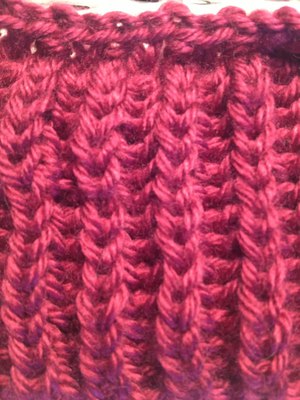Want to create a ribbed pattern, but with a little more stretch and flair? Try the brioche stitch. A brioche pattern looks similar to a knit, purl rib but with more give in the final product. The key to the brioche stitch is a slip stitch, yarnover combination.
Some brioche patterns refer to a knit two together (k2tog). Some instead use the abbreviation brk. Though both are referring to the same thing: knitting the slipped stitch and its neighboring yarnover together. The brk abbreviation refers to brioche knit.

A brioche pattern requires one set-up row, where you first add in yarnovers. This first row will not involve any k2togs because there isn’t yet anything to knit together. During this set-up row, you will slip one stitch knitwise, yarnover, and then knit 1 for the length of the row. Because the yarnovers will always be knitted with the slipped stitch right next to them, you aren’t really increasing stitches.
On Row 2, you’ll move in to your pattern. You will knit the slipped stitch and yarnover together (k2tog or brk) then slip one and yarnover for the length of the row. For the basic brioche pattern, you will just repeat row 2 for the length of your project. The stitch pattern becomes intuitive as you get to understand it. Remember that the yarnover is never its own stitch but is always worked with its slipped stitch buddy.
You can also work the pattern with the yarnover coming before the slipped stitch. It may seem tricky to start a row with a yarnover, but it will hold as soon as you knit into your first knit stitch.
The basic brioche pattern repeat itself works with an even number of stitches. If you’re making a scarf or blanket, you might to add on a selvedge stitch. This way, you’ll have a more finished look to your edge. Slip the first stitch of each row knitwise before launching into your pattern. Then you’ll have one extra stitch at the end of each row that you will knit. Just remember that slipped stitch at the start of the row is not part of the pattern.
You can also vary brioche by starting with an uneven number of stitches. This will involve a two-row repeat where one row will have an additional brk and the other row will have one additional slip-yarnover combo. Or you can work brioche with purls instead of knits.
As you finish your project, it can help to do a final row that does not include any yarnovers before you bind off. You can do a purl, knit rib pattern on that last row to keep the rib look while you get rid of pesky yarnovers before the bind-off row. Finally, when brioche knitting, be careful to bind off loosely. Part of the appeal of the brioche stitch is the stretchiness of the fabric, so you won’t want to constrict the fabric with a too-tight bind-off.

This is a good description. The explanation in my Vogue Knitting book now makes sense. Thank you
This article would be more helpful if the stitch instructions were written out together like one might see in a pattern, perhaps at the end of the article, in addition to being scattered across all the paragraphs.